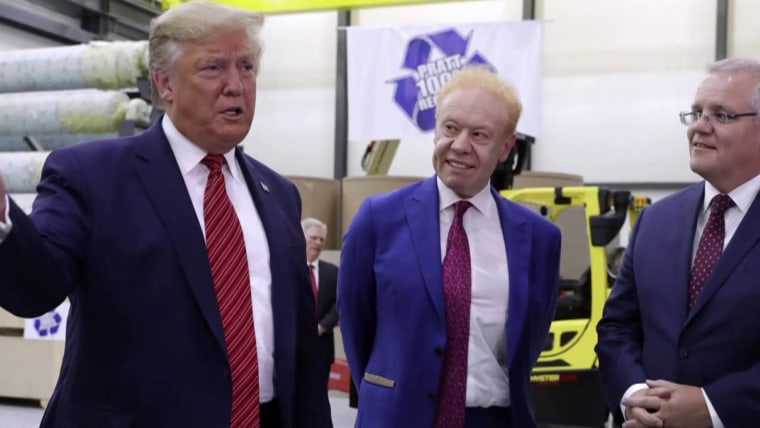After President Joe Biden sat down with CNN’s Fareed Zakaria in July to talk about U.S. policy in Ukraine, Donald Trump published a long, rambling statement in which he accused his White House successor of “a great breach of classified information.”
As soon became clear, the former president had no idea what he was talking about — Biden hadn’t disclosed anything sensitive — but just as notable was the irony of the circumstances. Because if there’s anyone in American politics who should avoid talking about breaches of classified information, it’s Trump.
Take this New York Times report, for example.
Shortly after he left office, former President Donald J. Trump shared apparently classified information about American nuclear submarines with an Australian businessman during an evening of conversation at Mar-a-Lago, his private club and residence in Florida, according to two people familiar with the matter. The businessman, Anthony Pratt, a billionaire member of Mar-a-Lago who runs one of the world’s largest cardboard companies, went on to share the sensitive details about the submarines with several others, the people said. Mr. Trump’s disclosures, they said, potentially endangered the U.S. nuclear fleet.
According to the Times’ report, which has not been independently verified by MSNBC or NBC News, special counsel Jack Smith’s office learned of the alleged disclosures and interviewed Pratt as part of the federal investigation.
ABC News was first to report on the story, relying on “sources familiar with the matter.”
In case this isn’t already obvious, people in positions of authority are not supposed to share classified information about American nuclear submarines with anyone, much less foreign billionaires.
This story comes on the heels of related allegations from federal prosecutors, who have accused the former president of, among other things, storing nuclear secrets at his glorified country club. As part of the same case, the criminal indictment against the Republican also pointed to other alleged instances in which Trump showed classified information to those who lacked the necessary clearance.
In fact, as regular readers know, Trump has allegedly been so careless with national security secrets on so many occasions that I’ve put together a Top 10 list documenting the phenomenon. Now seems like a good time to update our recent coverage:
#10. In May 2017, Trump had a chat with Philippine President Rodrigo Duterte in which the Republican shared information about dispatching two nuclear submarines off the coast of the Korean peninsula. By one account, Pentagon officials were “in shock“ over Trump’s willingness to share such information. “We never talk about subs!” three officials told BuzzFeed News, referring to the military’s belief that keeping submarines’ movements secret is key to their mission.
#9. In July 2019, Trump had an unsecured conversation with U.S. Ambassador to the E.U. Gordon Sondland, while the ambassador was in a Ukrainian restaurant within earshot of others, in which Trump sought information on Ukraine helping target the president’s domestic political opponents. Larry Pfeiffer, a former senior director of the White House Situation Room and a former chief of staff to the CIA director, said of the call, “The security ramifications are insane.”
#8. According to evidence gathered by the special counsel’s office, Trump showed a classified map to a representative of his political action committee, and then made matters slightly worse by showing a highly confidential war plan to a writer. (“Secret. This is secret information. Look, look at this,” Trump was recorded saying, adding, “Isn’t that incredible?” ... It’s so cool.”)
#7. In February 2017, Trump discussed sensitive details about North Korea’s ballistic missile tests with the prime minister of Japan at a Mar-a-Lago dining area, in view of wealthy civilians/customers.
#6. In early October 2019, Trump publicly discussed American nuclear weapons in Turkey, something U.S. officials have traditionally avoided disclosing and/or confirming.
#5. In August 2019, Trump published a tweet about a failed Iranian launch, which included a detailed photo. As MSNBC’s Andrea Mitchell reported, it wasn’t long before experts marveled at Trump’s recklessness with classified material.
#4. In October 2019, Trump needlessly blurted out all kinds of tactical and operational details about the al-Baghdadi mission in Syria. As NBC News reported at the time, “A few of those colorful details were wrong. Many of the rest were either highly classified or tactically sensitive, and their disclosure by the president made intelligence and military officials cringe, according to current and former U.S. officials.”
#3. In 2020, Trump disclosed the existence of a secret nuclear weapons program to Bob Woodward, to the surprise of national security insiders.
#2. In 2021, Trump allegedly shared classified information about American nuclear submarines with an Australian businessman, who allegedly proceeded to share the sensitive details with several others, for no apparent reason. The disclosures, the New York Times reported, “potentially endangered the U.S. nuclear fleet.”
#1. Just four months into Trump’s presidency, the Republican welcomed Russian Foreign Minister Sergei Lavrov and Russian Ambassador to the U.S. Sergei Kislyak into the Oval Office — at the request of Russia’s Vladimir Putin — for a visit that was never fully explained.
It was in this meeting that Trump revealed highly classified information to his Russian guests for no apparent reason. The Washington Post reported at the time, “The information the president relayed had been provided by a U.S. partner through an intelligence-sharing arrangement considered so sensitive that details have been withheld from allies and tightly restricted even within the U.S. government, officials said.”
The Wall Street Journal added, “According to one U.S. official, the information shared was highly sensitive and difficult to acquire and was considered extraordinarily valuable.” It’s never been altogether clear why Trump simply handed this to Putin’s representatives.
This list, incidentally, is not comprehensive. There are other examples.
If Trump really wants to have conversations about who's responsible for “great breaches of classified information,” that's a terrific idea.
This post updates our related recent coverage.

